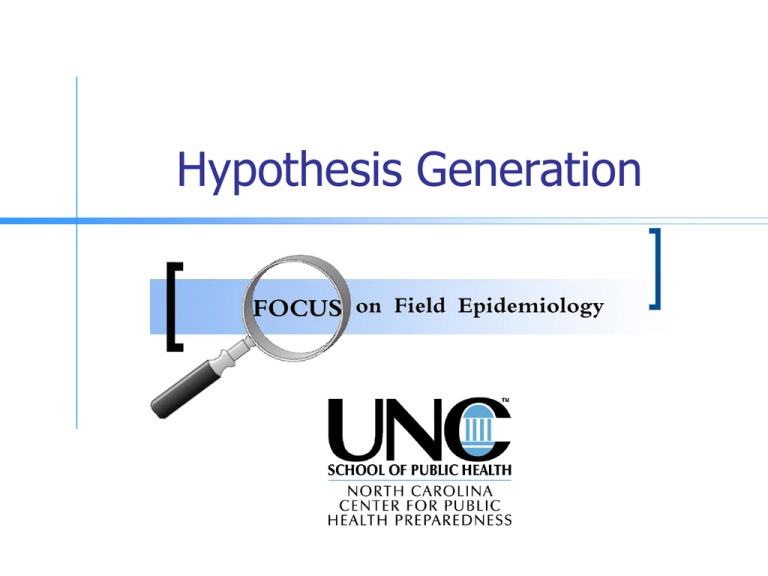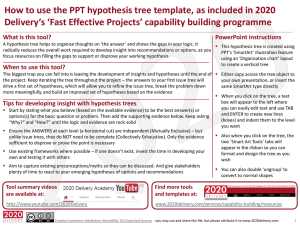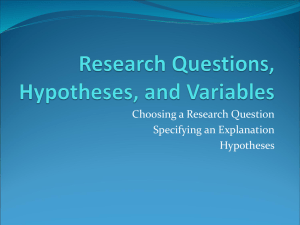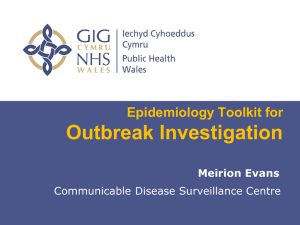Hypothesis Generation - North Carolina Institute for Public Health
advertisement

Hypothesis Generation Goals Discuss the importance of hypothesis generation Describe approaches to generating hypotheses Present Internet resources useful for literature reviews What is Hypothesis Generation and Why is it Important? A hypothesis is an educated “guess” about the source of the outbreak Generating hypotheses enables the investigators to test these hypotheses in an analytic study The success of the investigation depends upon the quality of the hypotheses Overview of Hypothesis Generation Strategy Ways to approach generating hypotheses about the cause of the outbreak Examine the line listing data Review the existing body of knowledge Administer open-ended hypothesisgenerating questionnaire to several cases Overview of Hypothesis Generation Strategy Develop specific hypotheses Test the hypotheses in an analytic study using a structured questionnaire concerning the specific hypotheses Overview of Hypothesis Generation Strategy Review the existing body of knowledge to learn about previous outbreaks caused by the same organism or disease Read medical, epidemiology, microbiology, and veterinary (if relevant) literature Talk to experts in the field Overview of Hypothesis Generation Strategy Literature reviews help identify organisms, risk factors, and sources of exposures that have been observed in the past Example: diarrheal disease Overview of Hypothesis Generation Strategy Some outbreaks are caused by unrecognized agents or through unrecognized modes of transmission Examples: hantavirus and West Nile virus Overview of Hypothesis Generation Strategy Familiarity with the microbiology, natural history, and ecologic niche of the organism may also be helpful Example: Blastomyces dermatitidis and hantavirus pulmonary syndrome Overview of Hypothesis Generation Strategy Utilization of existing hypothesisgenerating resources may save time CDC has a standard questionnaire template for conducting initial interviews and generating hypotheses in foodborne disease outbreak investigations: http://www.cdc.gov/foodborneoutbreaks/ standard_questionnaire.htm Overview of Hypothesis Generation Strategy Estimate the maximum incubation period from the illness onset date Use interviews to elicit information about exposure during the incubation period Using the Internet Sources of electronic full-text information Centers for Disease Control and Prevention (CDC): http://www.cdc.gov Morbidity and Mortality Weekly Report (MMWR): http://www.cdc.gov/mmwr Using the Internet General searches on the Internet can also be helpful Example: http://www.google.com Not all information on the Internet is accurate: be mindful of the potential credibility of different Internet-based sources Using the Internet PubMed allows individuals to search journal abstracts from biomedical literature for free http://www.ncbi.nlm.nih.gov/PubMed Some states or academic institutions also have agreements to provide access to journal abstracts or full-texts Using the Internet While abstracts provide valuable information, it may be necessary to read some articles in their entirety Articles may be available for free online Articles may be copied from journals in a library “Loansome Doc” allows users to order fulltext copies of articles for a fee http://www.nlm.nih.gov/loansomedoc/loansom e_home.html How to Perform a PubMed Search Use the Boolean operators “AND,” “OR,” and “NOT” Boolean operators should be capitalized Boolean operators are processed from left to right Parentheses can be used to group terms together How to Perform a PubMed Search Example: A search for “Salmonella AND eggs OR chicken” will retrieve all articles about Salmonella and eggs as well as all articles about chicken (in general) A search for “Salmonella AND (eggs OR chicken)” will retrieve all articles about Salmonella and eggs as well as all articles about Salmonella and chicken How to Perform a PubMed Search Ways to broaden or limit a search Example: “Salmonella” returns approximately 50,000 articles “Salmonella AND outbreak AND food” returns approximately 500 articles “Salmonella AND outbreak AND eggs” returns approximately 100 articles How to Perform a PubMed Search Another useful tool is the “Cubby” Requires a user-defined log-in and password, but is free Allows the user to run a search Click Cubby link to store the search Click the “What’s new for selected” button to retrieve any new articles since the last search How to Perform a PubMed Search The “History” button is also helpful Is located on the “Features” bar Is only available after performing a search Allows one to view a list and number of searches in the order in which they were run How to Perform a PubMed Search Tips for printing citations or abstracts After performing a search, select “Summary” from the “Display” drop-down bar and "Text” from the “Send to” dropdown bar Click on “Send to” for a printable version of the citations Select the “Abstract” option from the “Display” drop-down bar to print the abstract Case Study 1997 outbreak of E coli O157:H7 infections in Michigan and Virginia Hypothesis-generating interviews Demographic profile Lettuce and alfalfa sprouts 70% women Median age was 31 Hypothesis testing Case-control study method Conclusion Hypothesis generation should be guided by: Descriptive epidemiology from the outbreak Information learned from past outbreaks However, keep an open mind and always consider alternative explanations Example: Legionnaires’ Disease Conclusion Hypothesis generation is a critical step in any outbreak investigation A literature review may be necessary The Iinternet is a useful resource Preliminary data collection with standardized questionnaires may implicate hypotheses that warrant additional data Open-ended interviews can be a useful tool to obtain this information References 1. CDC. Outbreak of acute illness-Southwestern United States, 1993. MMWR Morb Mortal Wkly Rep. 1993;44(22):421-424. 2. CDC. Public health dispatch: West Nile Virus infection in organ donor and transplant recipients --- Georgia and Florida, 2002. MMWR Morb Mortal Wkly Rep. 2002;51(35):790. 3. Davies SF, Sarosi GA. Epidemiological and clinical features of pulmonary Blastomycosis. Semin Respir Infect. 1997;12 (3):206-218. References 4. Breuer T, Benkel DH, Shapiro RL, et al. A multistate outbreak of Escherichia coli O157:H7 infections linked to alfalfa sprouts grown from contaminated seeds. Emerg Infect Dis. 2001;7(6):977-982. Available from http://wwwcdc.gov/ncidod/eid/vol7no6/breuer.htm. 5. Garbe PL, Davis BJ, Weisfeld JS, et al. Nosocomial Legionnaires' disease. Epidemiologic demonstration of cooling towers as a source. JAMA. 1985;254:521-524.











